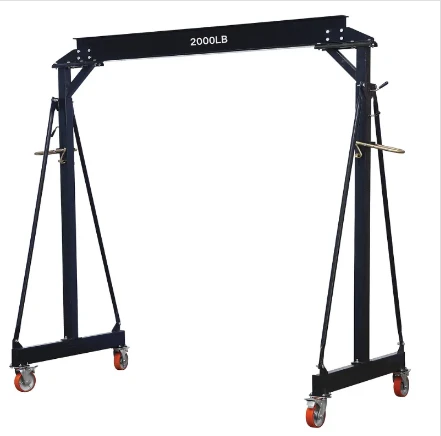Robust High-Capacity Gantry Crane for Industrial Applications and Heavy Lifting Tasks
Heavy Duty Gantry Crane An Essential Tool for Industrial Applications
In the world of heavy lifting and industrial operations, the heavy duty gantry crane stands as a critical piece of equipment that enhances efficiency, safety, and productivity. These cranes are specifically designed to handle substantial loads in various environments, from construction sites to shipping yards, and are integral to numerous sectors including manufacturing, warehousing, and infrastructure development.
Design and Structure
Heavy duty gantry cranes are characterized by their robust structure, which typically consists of a bridge supported by two or more legs. These cranes can be fixed or movable, with many featuring wheels that allow them to traverse long distances along tracks. The span of the bridge varies, allowing it to accommodate different sizes of loads and workspace configurations. The materials used in constructing these cranes are chosen for strength and durability, often incorporating high-grade steel to ensure resilience under demanding conditions.
Capabilities and Features
One of the standout features of heavy duty gantry cranes is their impressive lifting capacity, which can reach several hundred tons. This makes them ideal for lifting large objects such as shipping containers, heavy machinery, and industrial components. Many models come equipped with advanced technology, including radio remote controls, which allow operators to command the crane from a safe distance, enhancing overall safety.
Additionally, heavy duty gantry cranes often include features such as adjustable spans and heights, allowing for flexibility in operation. They can be integrated with other technologies, such as load monitoring systems and automated controls, to improve precision and reduce the risk of human error. This integration is crucial in complex industrial environments where precision handling is paramount.
heavy duty gantry crane

Safety Considerations
Safety is a major concern in any industrial operation, and heavy duty gantry cranes are designed with this in mind. Features such as anti-collision systems, emergency stop buttons, and load limiters are standard in modern cranes. Regular maintenance and inspections are essential to ensure these safety features are functioning correctly, thereby minimizing the risk of accidents.
Proper operator training is also critical for ensuring safety when operating these cranes. Operators must understand the machinery's capabilities and limitations and be familiar with the best practices for lifting and moving materials. Many organizations invest in comprehensive training programs to equip their employees with the necessary skills to operate heavy duty gantry cranes safely.
Applications Across Industries
Heavy duty gantry cranes are versatile and can be found in a variety of applications. In shipyards, they are used to load and unload containers, while in manufacturing plants, they lift components for assembly or transport. They are also utilized in warehouses for moving goods and in construction sites for lifting heavy beams and prefabricated sections of buildings. Their ability to adapt to different settings and tasks makes them indispensable in many industries.
Conclusion
In conclusion, the heavy duty gantry crane is a vital piece of equipment for any operation that requires the lifting of heavy loads. With their robust design, advanced features, and adaptability in various environments, these cranes play a significant role in enhancing productivity and safety in industrial settings. As technology continues to evolve, we can expect further advancements in the design and functionality of heavy duty gantry cranes, ensuring they remain at the forefront of heavy lifting solutions for years to come. Investing in high-quality gantry cranes is not just a financial decision but a commitment to improving operational efficiency and safety in the workplace.
-
Unlock Seamless Relocation with Our Heavy Equipment Moving ExpertiseNewsJun.06,2025
-
Unleash Unrivaled Flexibility with Our Adjustable Gantry CraneNewsJun.06,2025
-
Unleash Heavy-Duty Efficiency with Our Industrial Gantry Crane SolutionsNewsJun.06,2025
-
Revolutionize Steel Handling with Our Magnetic Lifter RangeNewsJun.06,2025
-
Master Equipment Mobility with Premium Machinery Mover SolutionsNewsJun.06,2025
-
Elevate Your Material Handling with Magnetic Lifter TechnologyNewsJun.06,2025
-
YS Permanent Lifting Magnets: The Smarter Way to Handle SteelNewsMay.22,2025
